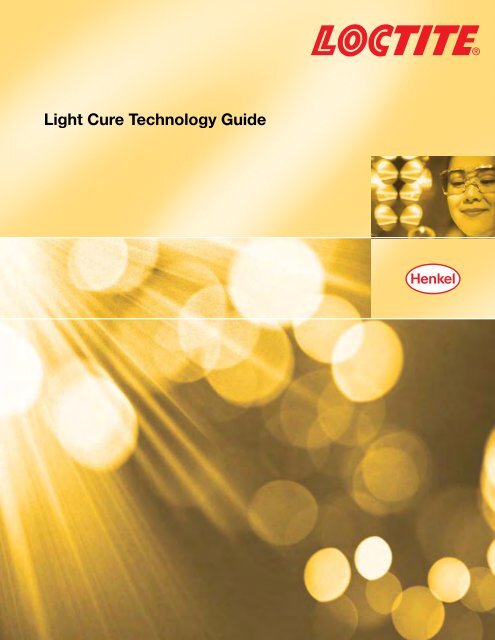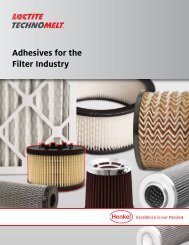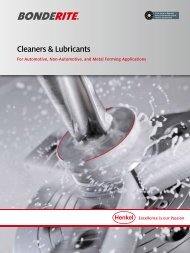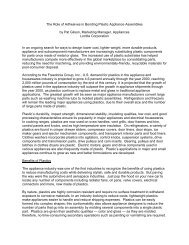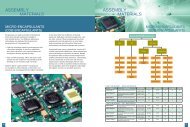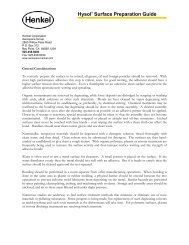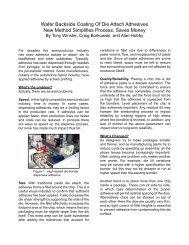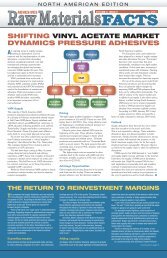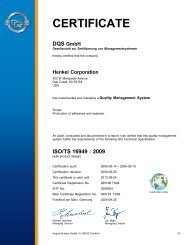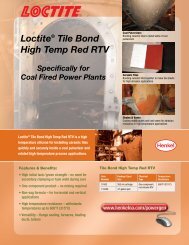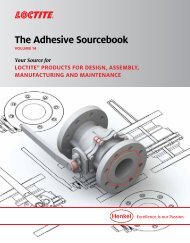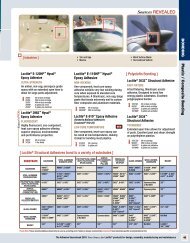Loctite Light Cure Technology Guide - Henkel North America
Loctite Light Cure Technology Guide - Henkel North America
Loctite Light Cure Technology Guide - Henkel North America
You also want an ePaper? Increase the reach of your titles
YUMPU automatically turns print PDFs into web optimized ePapers that Google loves.
TABLE OF CONTENTS<br />
TABLE OF CONTENTS
INTRODUCTION<br />
INTRODUCTION<br />
VIRTUALLYV<br />
ALL ADHESIVES<br />
S,<br />
SEALANTS AND COATINGS REQUIRE A CURING OR HARDENING PROCESS.<br />
THIST<br />
PROCESS MAY BE AS SIMPLE AS THE COOLING OF A HOT MELT ADHESIVE<br />
OR THE EVAPORATION<br />
OF SOLVENT<br />
FROM A CONTACT CEMENT,<br />
OR IT CAN BE MORE COMPLEX AND INVOL<br />
VE<br />
A CHEMICAL<br />
REACTION,<br />
AS IS THE CASE WITH EPOXY,<br />
ANAEROBIC AND LIGHT CURING ADHESIVES<br />
.<br />
ADVANTAGES<br />
The primary advantage of light cure processing is speed<br />
of cure. Depending on the product and system, cures<br />
can be achieved within seconds. Other benefits include:<br />
<br />
<br />
<br />
<br />
one part systems – no need to measure or mix, no<br />
pot life concerns<br />
no solvents<br />
very fast room temperature cure<br />
cure on command – facilitates parts alignment<br />
requires less equipment space and energy than ovens<br />
allows testing of parts soon after assembly –<br />
eliminates the possibility of large quantities<br />
of work in process scrap<br />
LIMITATIONS<br />
The primary limitation of a light cure system is that<br />
the material to be cured must see suitable light —<br />
both in type (wavelength or spectral distribution) and<br />
intensity. This means that in an adhesive application,<br />
one substrate must transmit appropriate light. Also,<br />
assemblies with shaded or shadowed areas (areas<br />
not exposed to light) will require a secondary cure<br />
mechanism.<br />
1
BASIC PRINCIPLES<br />
BASIC PRINCIPLES<br />
THE ELECTROMAGNETIC SPECTRUM<br />
Energy is needed to effect a chemical reaction. UV and visible light are examples of<br />
radiant energy — energy transmitted from a high temperature source to a receiving<br />
body without the use of any matter in between. UV and visible light actually<br />
comprise a very small portion of the electromagnetic spectrum, which is an ordering<br />
by wavelength of all types of radiant energy found on earth. UV light extends<br />
from 100-400 nm (nanometers) and visible light from 400 to about 760 nm in<br />
wavelength. A nanometer is one billionth of a meter (10 -9 meter) or 10 angstroms.<br />
<strong>Light</strong> in the UV or visible region which is capable of interacting with matter to<br />
produce chemical reactions is also referred to as actinic light.<br />
THE ELECTROMAGNETIC SPECTRUM<br />
The diagram above illustrates the types of radiant<br />
energies and associated wavelengths which make<br />
up the electromagnetic spectrum.<br />
2
BASIC PRINCIPLES<br />
BASIC PRINCIPLES<br />
TYPES OF UV LIGHT<br />
As indicated in the diagram on page 2, UV light is<br />
subdivided into four groups based on wavelength/<br />
energy and ability to interact with matter:<br />
UVA (315-400 nm)<br />
UVB (280-315 nm)<br />
UVC (200-280 nm)<br />
VUV (200-100 nm)<br />
Blacklight. Used for low energy<br />
UV polymerization reactions;<br />
also for fluorescent inspection<br />
purposes.<br />
Used with UVA for<br />
polymerization and, since<br />
it is the most energetic<br />
region of natural sunlight,<br />
for accelerated light aging<br />
of materials. UVB light is<br />
responsible for suntanning.<br />
Used for rapid surface cure of<br />
UV inks and lacquers; also for<br />
sterilization and germicidal<br />
applications.<br />
Vacuum UV. Can only be used<br />
in a vacuum and is therefore of<br />
minor commercial importance.<br />
COMMERCIAL USE OF RADIANT ENERGY<br />
Radiant energy found in nature is generally diffuse.<br />
In order to make radiant energy economically and<br />
commercially useful, people must be able to generate<br />
it at will and be able to intensify during its generation.<br />
Designing equipment that efficiently and economically<br />
produces suitably intense radiation for industrial<br />
use, whether UV, X-ray or any other type, is a<br />
continuing challenge.<br />
LIGHT INDUCED POLYMERIZATION<br />
In order for a light cure adhesive to react to UV or<br />
visible light, a chemical called a photoinitiator must<br />
be present in the formulation. <strong>Light</strong> emitted from a<br />
suitable source causes the photoinitiator to fragment<br />
into reactive species. These fragments initiate a rapid<br />
polymerization process with monomers and oligomers<br />
in the system to form a cross-linked, durable polymer.<br />
Combinations of UV and visible reactive photoinitiators<br />
are often used in newer products to enhance versatility.<br />
TYPES OF VISIBLE LIGHT<br />
Visible light is also subdivided, with different colors<br />
being associated with different wavelengths, as shown<br />
in the diagram of the electromagnetic spectrum.<br />
Vis (400-480 nm)<br />
Wavelengths used for visible<br />
light cure are in the violetto-blue<br />
region (400-480 nm).<br />
<strong>Henkel</strong>’s Indigo Visible <strong>Light</strong><br />
<strong>Cure</strong> adhesive products cure in<br />
the pure visible spectrum above<br />
450 nm.<br />
3
CHEMISTRY<br />
CHEMISTRY<br />
4<br />
TYPES OF LIGHT CURE CHEMISTRIES<br />
IGHT CURE PRODUCTS USED IN INDUSTRY TODAY ARE BASED<br />
ON THREE MAJOR TYPES OF POLYMERIZATI<br />
ON CHEMISTRIES:<br />
FREE RADICAL, ANIONIC AND CATI<br />
ONIC.<br />
FREE RADICAL<br />
ACRYLIC<br />
The majority of commercial light cure products are<br />
of the free radical acrylic type. Upon exposure to<br />
suitable light, extremely rapid polymerization occurs.<br />
Polymerization stops as soon as the light is removed.<br />
Free radical acrylic systems are subject to oxygen<br />
inhibition, which means that oxygen in the air prevents<br />
the molecules at the surface from polymerizing,<br />
leaving a wet or tacky surface. This phenomenon can<br />
be minimized through proper selection of product,<br />
equipment and optimization of the process. Free<br />
radical acrylic systems are the most versatile of all light<br />
cure systems because many different types of monomers<br />
and oligomers are available for the formulator to obtain<br />
different properties.<br />
SILICONE<br />
<strong>Light</strong> cure silicones are another type of free radical<br />
system. <strong>Henkel</strong> has developed two types of proprietary<br />
silicones that cure upon exposure to light — silicones<br />
that cure completely upon light exposure and dual<br />
cure silicones. Dual cure silicones cure partially<br />
upon exposure to UV light, followed by a secondary<br />
moisture cure mechanism that completes the cure,<br />
cures shadowed areas and provides enhanced adhesion.<br />
Both systems require high intensity UV light for curing.<br />
Like acrylics, light cure silicones are inhibited by<br />
oxygen. <strong>Light</strong> cure silicones provide outstanding low<br />
temperature flexibility, excellent electrical properties<br />
and a high degree of water resistance.<br />
HYBRID<br />
Hybrid light cure systems utilize a combination of<br />
standard epoxy chemistry, e.g., a two-part mix epoxy/<br />
hardener, and free radical acrylic chemistry. Acrylic<br />
monomer and photoinitiator are added to one of the<br />
epoxy components. After mixing the two parts, exposure<br />
to light causes the product to gel firmly, resulting<br />
in a fast fixture. This feature enhances productivity.<br />
Subsequent cure of the epoxy at room temperature or by<br />
heat generates properties typical of epoxies.<br />
ANIONIC<br />
<strong>Light</strong> cure cyanoacrylates utilize an anionic dual<br />
cure mechanism. Polymerization is effected by both<br />
UV/visible light and by the basic surface. <strong>Light</strong> cure<br />
cyanoacrylates offer the substrate versatility of<br />
conventional cyanoacrylates, including adhesion to<br />
elastomers and polyolefins (with primer), with the<br />
added benefits of low blooming, no oxygen inhibition,<br />
excellent cure in areas not exposed to light and the<br />
ability to cure through large gaps.<br />
CATIONIC<br />
Cationic systems contain epoxy and/or vinyl ether<br />
materials along with other components to modify<br />
properties. Because a fairly limited variety of monomers<br />
and oligomers are available for use in these systems,<br />
versatility in tailoring properties is not as great as<br />
with acrylic systems. Unlike free radical systems, some<br />
cure continues after the light source is removed, but<br />
this is minimal and often requires a thermal bump,<br />
or heating, to be effective. The photoinitiators used<br />
in cationic systems can be somewhat toxic and their<br />
residues can be corrosive, e.g., to delicate platings used<br />
in the electronics industry. Reactivity of cationics may<br />
be decreased by exposure to high humidity. Cationic<br />
systems are not subject to oxygen inhibition and<br />
therefore exhibit excellent surface cure. Cationics<br />
also typically offer high thermal resistance and low<br />
outgassing.<br />
Pre-activated cationic systems provide similar benefits<br />
and limitations as the cationic systems. The difference<br />
with these materials is that the system is exposed prior<br />
to assembly to start the reaction. Once the assembly is<br />
mated, the reaction continues to a thermoset material.<br />
The benefit is that you can cure through opaque parts<br />
or in areas that will not see exposure.
EQUIPMENT<br />
EQUIPMENT<br />
BASIC EQUIPMENT COMPONENTS<br />
<br />
<br />
<br />
<br />
<br />
THE LIGHT SOURCE<br />
The heart of a light cure system is, of course, the lamp<br />
or light emitting diode (LED). Many types of lamps are<br />
available and the choice of a particular lamp depends<br />
both on technical needs and on economic constraints.<br />
The two most important characteristics which<br />
determine how fast and effectively a lamp will cure a<br />
product are spectral outputt<br />
and intensity.<br />
SPECTRAL OUTPUT<br />
Spectral output is defined as intensity of light at each<br />
wavelength over the range of wavelengths emitted<br />
by the lamp. For the most effective cure, this pattern of<br />
output must be matched to the pattern of absorption of the<br />
photoinitiator in the product. This principle forms the<br />
basis of all successful light cure applications. Spectral<br />
output determines whether a lamp is suitable for a<br />
particular application and how effectively the lamp<br />
will cure the product. Basic lamp engineering and<br />
modifications of the material inside the lamp (called<br />
doping) enable shifting of the spectral output to other<br />
wavelengths. Figures 1-7 illustrate spectral output<br />
characteristics of various lamps commonly used in<br />
industry.<br />
Since there are certain absorption maxima common<br />
to many systems, there is often a choice of lamps for a<br />
given product. Major absorption areas of importance<br />
are 254 nm, responsible for surface cure, 365 nm,<br />
the “workhorse” cure wavelength and also effective<br />
in promoting depth cure, and 400-436 nm, where<br />
currently used visible photoinitiators absorb. Visible<br />
light cure is required for UV opaque substrates and for<br />
very large depth of cure.<br />
Because measurement of spectral output is not<br />
practical in an industrial environment, spectral<br />
output of the type of lamp in the equipment must be<br />
known. The supplier’s literature is the best source for<br />
this information. <strong>Henkel</strong> Technical Data Sheets provide<br />
information on recommended light sources for<br />
each product.<br />
5
EQUIPMENT<br />
EQUIPMENT<br />
INTENSITY<br />
Lamp intensity is defined as the overall power of the<br />
lamp and is most often designated in watts. Also called<br />
power density, intensity refers to total lamp output<br />
across the entire electromagnetic spectrum. Lamp<br />
intensity generally affects rate of cure of a particular<br />
product, since it is one of the factors determining the<br />
amount of light that actually reaches the product, e.g.,<br />
the light which induces the chemical reaction. Other<br />
factors affecting the quantity of light reaching the<br />
product are discussed on pages 13 and 14.<br />
It is important to distinguish between basic lamp<br />
intensity and intensity or amount of light at the<br />
working surface. The quantity of light at the working<br />
surface is defined in either intensity units or energy<br />
units. <strong>Light</strong> intensity at the product surface, described<br />
by the term irradiance, is a measure of momentary<br />
exposure and is most often quantified in milliwatts/cm 2 .<br />
<strong>Light</strong> energy at the surface is a measure of cumulative<br />
intensity exposure (intensity x time), also called dose,<br />
quantified as millijoules/cm 2 , and is simply:<br />
MW/CM 2 X SECONDS = MJ/CM 2<br />
Variations in use of these terms are summarized below:<br />
conditions and maintain consistency in cure results.<br />
Fortunately, easy-to-use equipment is available for this<br />
measurement. <strong>Henkel</strong> offers radiometers in different<br />
regions of the electromagnetic spectrum and for<br />
different types of equipment.<br />
LAMPS IN INDUSTRIAL USE<br />
LED<br />
LED (<strong>Light</strong> Emitting Diode) <strong>Technology</strong> has been<br />
widely used throughout the industry because of<br />
the numerous benefits an LED can provide. An LED<br />
provides a very narrow spectral output, which can<br />
minimize excessive exposure to other wavelengths. LED<br />
technology provides instant on/off capability and lasts<br />
much longer than a conventional bulb (i.e., mercury<br />
arc, electrodeless, etc.). Typically, an LED can last over<br />
10,000 hours, when most conventional electrode bulb<br />
technology fails after 2,000 hours at best. In addition,<br />
the LED technology does not generate significant heat<br />
and uses less power than conventional bulbs. Although<br />
there are other wave lengths, the spectral output of a<br />
405 nm LED is shown in Figure 1.<br />
<strong>Henkel</strong> has equipment that utilizes LED technology.<br />
1<br />
SPECTRAL OUTPUT OF A<br />
405 NM LIGHT EMITTING DIODE (LED)<br />
6<br />
One milliwatt/cm 2 equals one thousand microwatts/<br />
cm 2 ; one joule is one thousand millijoules.<br />
<strong>Henkel</strong> light cure products are often referred to as highor<br />
low-intensity (also called high or low energy) curing<br />
products. Generally speaking, a low-energy product<br />
will respond well to roughly 25-30 mW/cm 2 intensity,<br />
occasionally less, while high-intensity cure refers to the<br />
80-100 mW/cm 2 region and above.<br />
Measurement of irradiance (light intensity at the<br />
working surface) is essential in order to optimize cure<br />
Relative Irradiance<br />
0.9<br />
0.8<br />
0.7<br />
0.6<br />
0.5<br />
0.4<br />
0.3<br />
0.2<br />
0.1<br />
0<br />
370 380 390 400 410 420 430 440<br />
Wavelength (nm)<br />
Figure 1
EQUIPMENT<br />
EQUIPMENT<br />
MEDIUM PRESSURE MERCURY VAPOR LAMPS WITH<br />
ELECTRODES<br />
These lamps, also called mercury arc lamps, are the<br />
workhorse of the light curing industry. They combine<br />
cure efficiency with design versatility and moderate<br />
cost. An electrode type medium pressure mercury vapor<br />
lamp consists of three major components:<br />
<br />
<br />
<br />
a quartz glass sleeve<br />
fill material, typically argon and a small amount of<br />
liquid mercury<br />
electrodes sealed into the ends of the quartz sleeve<br />
A high voltage is applied to the lamp across the<br />
electrode terminals. The voltage field ionizes the argon<br />
and produces heat to vaporize the mercury, which<br />
creates a pressure of about two atmospheres. This<br />
pressure is needed to maintain a balance between the<br />
required high intensity while maintaining the spectral<br />
output essentially in the UV region. The mercury vapor<br />
arc which is created exhibits the unique property<br />
of high emission of light in the ultraviolet region of<br />
the spectrum. In particular, intense emissions occur<br />
in the 240-270 nm and 350-380 nm areas, which is<br />
where typical UV photoinitiators absorb. This intense<br />
light beyond the violet region of the visible spectrum<br />
has sufficient energy to interact with photoinitiators<br />
and cause their fragmentation, which initiates<br />
polymerization. Some visible light and infrared<br />
radiation are also generated. Figure 2 presents the<br />
spectral output of a typical medium pressure mercury<br />
vapor lamp.<br />
Electrode type mercury vapor lamps are available in<br />
sizes ranging from a few inches to about 80 inches in<br />
length and at various power levels ranging from 100<br />
watts/inch to 600 watts/inch. The most popular lamps<br />
are in the 200-300 watt/inch range. Intensity delivery on<br />
a part is high and can be in the 100-200 mW/cm 2 range.<br />
WARM UP AND COOL DOWN<br />
A disadvantage of mercury vapor lamps which have<br />
electrodes is that a warm-up and cooldown time is<br />
required. They cannot be turned on and off instantly.<br />
This problem is overcome somewhat by switching to<br />
1/2 or 1/3 power during down times. If a lamp is held at<br />
reduced power, it can be instantly raised to full power.<br />
A shutter is often used with the low power setting to<br />
block light from the cure area during the partial<br />
power time.<br />
INTENSITY DETERIORATI<br />
ON<br />
The intensity of output of a mercury vapor lamp with<br />
electrodes deteriorates with use. After 1,000 hours<br />
of use, the output will be reduced by 15%-25%. It is<br />
important to note that because lamp deterioration is<br />
seldom catastrophic, it is not easily perceptible. Regular<br />
monitoring of lamp intensity at the working distance is<br />
extremely important.<br />
<strong>Henkel</strong> has equipment that utilizes medium pressure<br />
mercury vapor lamps with electrodes.<br />
Relative Irradiance<br />
1<br />
0.9<br />
0.8<br />
0.7<br />
0.6<br />
0.5<br />
0.4<br />
0.3<br />
0.2<br />
0.1<br />
SPECTRAL OUTPUT OF A<br />
MEDIUM PRESSURE MERCURY<br />
VAPOR BULB<br />
0<br />
225 275 325 375 425<br />
Wavelength (nm)<br />
Figure 2<br />
7
EQUIPMENT<br />
EQUIPMENT<br />
HIGH PRESSURE MERCURY VAPOR LAMPS<br />
Mercury lamps, which can be spherical in shape, have<br />
electrodes, but feature portability and fast startup time.<br />
High pressure lamps are typically used in wand systems.<br />
The energy is delivered via a liquid light guide to the<br />
tip of the wand. Figure 3 shows the emission spectrum<br />
of this source.<br />
<strong>Henkel</strong> provides systems with high pressure mercury<br />
vapor lamp up to 20 W/cm 2 .<br />
SPECTRAL OUTPUT OF HIGH PRESSURE<br />
MERCURY VAPOR BULB<br />
system is a low to medium energy unit, delivering 20 to<br />
50 mW/cm 2 intensity at the part surface, depending on<br />
distance from the source. Figure 4 illustrates spectral<br />
output of the UV bulb, which is iron doped; Figure 5<br />
illustrates output of the visible bulb, which is Indium<br />
doped. <strong>Henkel</strong> metal halide cure equipment utilizes<br />
advanced light filtering technology that enhances<br />
cure response.<br />
1<br />
0.9<br />
SPECTRAL OUTPUT OF<br />
UV METAL HALIDE BULB<br />
0.8<br />
Relative Irradiance<br />
1<br />
0.9<br />
0.8<br />
0.7<br />
0.6<br />
0.5<br />
0.4<br />
0.3<br />
0.2<br />
0.1<br />
Relative Irradiance<br />
0.7<br />
0.6<br />
0.5<br />
0.4<br />
0.3<br />
0.2<br />
0.1<br />
0<br />
22 5<br />
Wavelength (nm)<br />
Figure 4<br />
0<br />
300 320 340 360 380 400 420 440 460<br />
Wavelength (nm)<br />
Figure 3<br />
1.2<br />
SPECTRAL OUTPUT OF<br />
VISIBLE METAL HALIDE BULB<br />
8<br />
METAL<br />
HALIDE LAMPS<br />
Metal halide lamps are a type of medium pressure<br />
mercury arc lamp (with electrodes) in which the<br />
spectral output is modified by addition of metal halides<br />
to the bulb contents. The most common dopant is an<br />
iron halide which enhances output in the UV region.<br />
Gallium or Indium halides are used to shift emission<br />
maxima to the visible region. <strong>Henkel</strong> offers a choice<br />
of two types of metal halide lamps. The metal halide<br />
Relative Irradiance<br />
1<br />
0.8<br />
0.6<br />
0.4<br />
0.2<br />
0<br />
225<br />
Wavelength (nm)<br />
Figure 5
EQUIPMENT<br />
EQUIPMENT<br />
ELECTRODELESS MERCURY VAPOR LAMPS<br />
The electrodeless mercury vapor lamp is a unique type<br />
of medium pressure lamp. In this design, the mercury<br />
in a quartz sleeve is vaporized by microwave energy<br />
rather than by the electrode process. Major advantages<br />
over lamps with electrodes include instant on-off<br />
capability, much longer bulb life (guaranteed for 8,000<br />
hours) and bulbs with a smaller diameter which, in<br />
combination with reflector design, results in higher<br />
efficiency. With electrodeless mercury vapor lamps,<br />
a very high intensity can be generated at a working<br />
surface, well in excess of 150 mW/cm 2 , enabling very<br />
high cure speed.<br />
Metal halide doping (adding a metal halide to the<br />
contents of a lamp) is used to change the spectral<br />
output of these bulbs. Spectral output of the three most<br />
popular electrodeless bulbs are shown in Figures 6a-c.<br />
The H bulb output is most similar to a conventional<br />
medium pressure mercury electrode type bulb output.<br />
In the V bulb, output has been shifted strongly into<br />
the visible region, while the D bulb has been tailored<br />
to exhibit characteristics of both bulbs. The D bulb is<br />
often used to achieve good cure depth. A new H+ bulb<br />
exhibits enhanced emission at shorter wavelengths,<br />
effective in promoting surface cure.<br />
Disadvantages of electrodeless bulbs include<br />
significantly higher cost not only for the bulb, but also<br />
for the entire system, and limited bulb length sizes,<br />
only six inches or ten inches. Length is limited by the<br />
size of magnetrons needed for microwave generation,<br />
but units may be placed in tandem.<br />
<strong>Henkel</strong> can supply electrodeless mercury vapor lamp<br />
technology.<br />
Relative Irradiance<br />
1<br />
0.9<br />
0.8<br />
0.7<br />
0.6<br />
0.5<br />
0.4<br />
0.3<br />
0.2<br />
0.1<br />
SPECTRAL OUTPUT OF VBULB<br />
0<br />
275 295 315 335 355 375 395 415 435 455 475<br />
Wavelength (nm)<br />
Figure 6b<br />
SPECTRAL OUTPUT OF HBULB<br />
SPECTRAL OUTPUT OF DBULB<br />
1<br />
1<br />
0.9<br />
0.9<br />
0.8<br />
0.8<br />
0.7<br />
0.7<br />
Relative Irradiance<br />
0.6<br />
0.5<br />
0.4<br />
0.3<br />
Relative Irradiance<br />
0.6<br />
0.5<br />
0.4<br />
0.3<br />
0.2<br />
0.2<br />
0.1<br />
0.1<br />
0<br />
225 275 325 375<br />
425<br />
Wavelength (nm)<br />
0<br />
2<br />
Wavelength (nm)<br />
75<br />
Figure 6a<br />
Figure 6c<br />
9
EQUIPMENT<br />
EQUIPMENT<br />
BLACKLIGHT LAMPS<br />
Blacklight lamps are a type of fluorescent lamp<br />
designed to emit in the UVA region. Since intensity is<br />
quite low, about 6-10 mW/cm 2 , they have limited use in<br />
a production environment, although they can be used<br />
for quality control purposes or with materials that<br />
cure under very low energy radiation. Spectral output<br />
maximizes in the 320-400 nm region (see Figure 7).<br />
Relative Irradiance<br />
1<br />
0.9<br />
0.8<br />
0.7<br />
0.6<br />
0.5<br />
0.4<br />
0.3<br />
SPECTRAL OUTPUT OF A<br />
BLACKLIGHT LAMP<br />
OTHER LIGHT SOURCES<br />
A pulsed Xenon or flash Xenon lamp utilizes Xenon gas<br />
and no mercury to generate UV, visible and infrared<br />
radiation. This equipment, often used for curing of<br />
fiber optic coatings, utilizes an energy storage capacitor<br />
to trigger the lamp system 120 times per second, with<br />
6-10 microsecond pulses, to yield bursts of very high<br />
energy and power peaks, as high as one million watts.<br />
Advantages are said to be very fast cure rates and<br />
degree of cure, excellent depth of penetration, low heat<br />
buildup, and instant on-off capability. A wide variety<br />
of lamp configurations is possible, although high cost,<br />
higher than electrodeless systems, is a disadvantage.<br />
Laser light sources are also used industrially. Several<br />
laser sources are available, including Argon, Krypton,<br />
and Helium/Cadmium. This technology is often used<br />
for rapid prototyping (stereolithography) operations.<br />
While laser sources produce very fast cure, cost is a<br />
consideration.<br />
0.2<br />
0.1<br />
0<br />
300 320 340 360 380 400 320 340<br />
Wavelength (nm)<br />
Figure 7<br />
10
EQUIPMENT<br />
EQUIPMENT<br />
THE REFLECTOR<br />
Depending on end-use application, it may be desirable<br />
to concentrate or focus the radiant energy on the<br />
target substrate (achieved via an elliptical reflector)<br />
or to diffuse or flood the light to produce an even<br />
distribution of light intensity over a surface (achieved<br />
via a parabolic reflector). Parabolic reflectors radiate<br />
light over the broadest possible cure area, but with the<br />
lowest light intensity at the substrate. Focused elliptical<br />
reflectors offer the highest possible light intensity,<br />
but the smallest exposure area. Also, a focused light<br />
generates significantly more heat, which may adversely<br />
affect the substrate. When using focused light, part<br />
positioning becomes critical since intensity drops off<br />
sharply as the distance from the focal point increases.<br />
An alternative is defocused light. This offers reasonably<br />
high intensities and somewhat broad cure areas by<br />
using focused light and positioning the substrate<br />
beyond the focal point.<br />
Basic reflector designs and lighting options are<br />
illustrated in Figure 8.<br />
ELLIPTICAL<br />
(FOCUSED)<br />
ELLIPTICAL<br />
(DEFOCUSED)<br />
PARABOLIC<br />
COOLING<br />
Even the most tailored mercury vapor ultraviolet<br />
light produces some infrared or heat energy. The heat<br />
generated must be removed, not only to protect the<br />
lamp, but also to prevent damage if thermally sensitive<br />
parts are being processed. Often, cooling by circulation<br />
of air through vents in back of the reflector is sufficient.<br />
However, additional cooling systems are available,<br />
including:<br />
water cooling of the lamp housing or reflector<br />
<br />
blowing refrigerated air between polished quartz<br />
plates above the work surface<br />
using a dichroic reflector or cold mirror<br />
Cooling of a lamp cannot be indiscriminate. The<br />
quartz sleeve of the lamp must be maintained at a<br />
temperature from 600-800°C. Below 600°C, the mercury<br />
will condense and the lamp will lose its arc; above<br />
800°C, the quartz sleeve will start to deteriorate. Lamp<br />
terminals on electrode style lamps must be kept below<br />
150°C to prevent damage to the seals. Although cooling<br />
lamps is critical to the success of the bulb vaporizing<br />
the mercury, the efficiency of the LED is also affected by<br />
heat and also must be actively cooled to provide<br />
high irradiance.<br />
Figure 8<br />
11
KEYS TO SUCCESS<br />
KEYS TO SUCCESS<br />
FOUR MAJOR FACTORS<br />
<br />
<br />
<br />
<br />
SPECTRAL OUTPUT/PHOTOINITIATOR MATCH<br />
One of the most important considerations in achieving<br />
optimum cure is to match the spectral output of<br />
the lamp to the absorbance characteristics of the<br />
photoinitiator system in the material to be cured. This<br />
is accomplished by coordinating lamp choice with<br />
product chemistry. As previously discussed, a variety of<br />
lamps with differing spectral outputs are available.<br />
Different photoinitiators have different absorption<br />
characteristics. The more intense a lamp’s emission at<br />
the wavelengths absorbed by a product’s photoinitiator,<br />
the more efficient the cure. Often, several light sources<br />
will cure a product with some degree of effectiveness,<br />
but one source may enhance particular properties<br />
required, e.g., surface cure or depth cure. While<br />
measurement of spectral output is not practical<br />
on-line, the equipment manufacturer will supply<br />
output diagrams of lamps used. <strong>Henkel</strong> Technical Data<br />
Sheets utilize <strong>Henkel</strong> equipment to generate data for<br />
each product.<br />
12
KEYS TO SUCCESS<br />
KEYS TO SUCCESS<br />
LIGHT INTENSITY ON PRODUCT<br />
FACTORS DETERMINING LIGHT INTENSITY<br />
Overall intensity of light on the product, irradiance,<br />
is a major factor influencing speed of cure–the more<br />
intense the light, the faster the cure speed.<br />
IRRADIANCE IS A FUNCTION OF:<br />
<br />
<br />
<br />
<br />
<br />
LAMP POWER<br />
As previously noted, lamp power is rated in watts per<br />
inch of length, also called power density. The mercury<br />
vapor arc lamps most commonly used in commercial<br />
light curing systems are available in power densities<br />
ranging from 100-600 watts/in., but the two most widely<br />
used are 200 and 300 watts/in. This value is total lamp<br />
output across the entire electromagnetic spectrum,<br />
including visible and infrared radiation, and does not<br />
indicate intensity at any particular wavelength.<br />
DISTAN<br />
CE FROM LAMP TO PRODUCT<br />
As with any source of light, the intensity at a surface<br />
decreases as the distance from the source increases. The<br />
distance-intensity relationship is significantly influenced<br />
by reflector design. In order for measurement of lamp<br />
intensity to be meaningful, readings must be taken at<br />
the working distance from the lamp and in the area<br />
where the adhesive is located during the curing process.<br />
TYPE OF REFLECTOR<br />
As discussed on page 11, reflector design affects<br />
intensity of light at the working surface. It is important<br />
to maintain a consistent working distance between the<br />
source and the product to be cured in order to keep<br />
reflector influence optimized.<br />
LAMP AGE<br />
The usable life of a mercury arc lamp depends on<br />
several factors, including whether it has electrodes or<br />
is electrodeless, number of starts, operating time per<br />
start, temperature in the electrode area of lamps with<br />
electrodes, and power density. Lamps with electrodes<br />
are expected to last 1,000 hours with loss of no more<br />
than 15%-25% of original intensity. Electrodeless lamps<br />
boast a 8,000 hour life. The best source for information<br />
on aging characteristics of specific lamps is the lamp<br />
or equipment manufacturer. Regular monitoring of<br />
lamp intensity at the working distance is extremely<br />
important. Equipment for monitoring intensity is<br />
readily available and is suited for use in an industrial<br />
environment.<br />
Visible LEDs will last for over 10,000 hours without<br />
degradation, which provides a very robust curing system.<br />
13
KEYS TO SUCCESS<br />
KEYS TO SUCCESS<br />
14<br />
TRANSMISSION CHARACTERISTICS OF SUBSTRAT<br />
E<br />
For effective photocure, light of suitable intensity<br />
and spectral distribution must reach the product.<br />
For a coating or potting application, once factors<br />
determining light intensity described on page 13 are<br />
known, effective cure of a product can be predicted.<br />
However, for an adhesive application in which the light<br />
must pass through a substrate before it reaches the<br />
product, one other critical factor must be considered –<br />
the substrate transmittance characteristics.<br />
Even though a material appears colorless and<br />
transparent to the eye, it may actually block out light<br />
needed for a UV cure. For example, while most clear<br />
glass types transmit UV light, Flint F Glass (D.E.D.F.<br />
5901) and polyvinyl butyral laminated safety glass filter<br />
out all light of 365 nm wavelength, which is needed<br />
for UV cure. Also, two basic types of visually clear<br />
polycarbonate (P/C) are common in industry today:<br />
UV-transmitting, typically used in medical device<br />
applications and UV-absorbing, used in auto headlamp<br />
and other outdoor applications. UV-transmitting P/C<br />
passes about 70% of 365 nm light, but UV-absorbing<br />
passes only about 3%, not enough to cure products<br />
containing only UV photoinitiator. Other types of<br />
clear plastics may also filter UV light. Visible light cure<br />
products usually offer the solution to achieving cure<br />
through clear UV filtering substrates, and with new<br />
visible light curing technology, it is often possible<br />
to cure through clear tinted or clear colored<br />
substrates also.<br />
Color and gloss of the bottom substrate can affect cure<br />
speed. The reflected light from a white or glossy bottom<br />
surface may speed cure while a black bottom substrate<br />
may slow cure.<br />
Measuring a substrate’s transmission characteristics is<br />
easily accomplished even in a production environment<br />
and should be performed before specifying a product.<br />
Radiometers with probes which detect light at 365 nm<br />
and at 400 nm should be used to determine if either a<br />
UV or visible cure is required. The substrate, with the<br />
probe underneath, is exposed to the light and intensity<br />
measurements which the adhesive will be exposed to<br />
during curing. Intensity without the substrate on top of<br />
the probe should also be measured to determine light<br />
filtering characteristics of the substrate.<br />
MEASURING LIGHT INTENSITY<br />
Because successful use of light curing products depends<br />
so much on light intensity, it is vitally important<br />
to measure and monitor this characteristic. For<br />
meaningful information, light must be measured under<br />
actual production conditions and through the substrate<br />
being assembled, if appropriate. Use of radiometers<br />
equipped with probes that respond to the generally<br />
critical wavelengths of 365 nm and/or 400 nm enables<br />
easy on-line measurements. It should be remembered<br />
that, even if intensity readings at a specific wavelength<br />
are similar between two light sources, cure efficiency<br />
may not be the same, due to the importance of the<br />
spectral distribution of the source. However, measuring<br />
at one wavelength is an excellent means of determining<br />
optimum intensity for a particular application and<br />
monitoring intensity to insure consistent cure results.<br />
BROAD VERSUS NARROW<br />
There are two types (broad range and specific<br />
wavelength) of radiometers on the market. If using a<br />
single wavelength radiometer, which measures the<br />
wavelength your adhesive cures at, you can accurately<br />
compare two different pieces of light cure technology<br />
equipment at that wavelength. If you are using a<br />
broad range radiometer, you have the potential to<br />
overexpose or underexpose the adhesive. The reason<br />
is that bulbs and LEDs have different spectral outputs.<br />
So, if you are measuring a bulb that has the highest<br />
peak at 365 nm, the broad range will pick up this<br />
maximum peak. However, if you have a bulb that has<br />
its highest peak at 325 nm, the broad range will peak<br />
up this peak and not the 365 nm peak, which is where<br />
the adhesive cures. To elevate this, testing along with<br />
broad range measurements is critical when comparing<br />
bulbs to ensure that the irradiance of the appropriate<br />
wavelength is being transmitted to the adhesive.
KEYS TO SUCCESS<br />
KEYS TO SUCCESS<br />
ACHIEVING NEEDED CURE PROPERTIES<br />
A further consideration involves selecting or adjusting<br />
options available in order to most effectively achieve<br />
the curing and cured product properties required for<br />
the specific use. These requirements include targeted<br />
cure speed, depth of cure (CTD) and surface cure.<br />
CURE SPEED<br />
<strong>Cure</strong> speed depends both on the composition of the<br />
product and on light intensity. Any factor that reduces<br />
light intensity on a product will reduce cure speed. For<br />
example, if the speed of a conveyor belt is increased<br />
to increase productivity, incomplete cure may occur<br />
due to decreased time of exposure to light. However<br />
it is important to note that problems may also occur<br />
if the product cures too fast. One concern is high<br />
heat generation. Excessive heat may adversely affect<br />
thermally sensitive parts, produce cracking in the<br />
cured product, or cause fogging due to volatilization of<br />
the normally non-volatile components in the product.<br />
A more subtle but significant negative effect of too<br />
rapid a cure is the possibility of reduced adhesion to<br />
the substrate.<br />
DEPTH OF CURE<br />
<strong>Cure</strong> depth is enhanced by longer wavelengths, e.g.,<br />
greater than 350 nm. For very large cure depths, visible<br />
light cure systems are recommended. CTD is a function<br />
of product chemistry, light source and time of exposure<br />
and can be found in the <strong>Henkel</strong> Technical Data Sheets for<br />
each <strong>Henkel</strong> product. <strong>Cure</strong> depth may be enhanced —<br />
or cure in shadowed areas may be achieved — by use of<br />
dual cure systems which are formulations into which<br />
a secondary cure mechanism has been incorporated<br />
(heat, moisture or activator).<br />
SURFACE CURE<br />
Surface cure, on the other hand, is enhanced by<br />
exposure to shorter, more energetic wavelengths.<br />
Surface cure may not be important in an adhesive<br />
application, except if there is a large fillet, but is<br />
obviously important for coating, tacking or potting<br />
applications. As previously indicated, acrylic systems<br />
are subject to oxygen inhibition which adversely affects<br />
surface cure. Inerting the atmosphere with nitrogen is<br />
effective in overcoming this problem and is used in the<br />
coating industry, but is not practical for most specialty<br />
uses. The best resolution to this problem is careful<br />
selection of product and cure equipment parameters<br />
and use of high energy, particularly at 254 nm. Both<br />
medium pressure mercury arc lamps and the Fusion H<br />
and H+ bulb emit strongly at 254 nm.<br />
WHEN IS THE PRODUCT CURED?<br />
Determining when a product is fully cured depends on<br />
the application. Currently there is no on-line method<br />
of determining cure (e.g., by color or fluorescence<br />
change). An instrument has been developed for<br />
determining cure of coatings on a production line,<br />
but it is costly and its practical use to determine cure<br />
between substrates, as in an adhesive bond, has yet<br />
to be demonstrated. Methods which may be used to<br />
determine cure in specific application areas are given<br />
below. Tests should always be conducted on actual parts<br />
processed in the actual production environment.<br />
<br />
<br />
<br />
<br />
Once cure conditions have been tuned to satisfaction,<br />
all variables should be closely controlled and regularly<br />
monitored to insure consistent results.<br />
15
SAFETY<br />
SAFETY<br />
HAZARDS TO PERSONNEL<br />
<br />
<br />
<br />
<br />
ULTRAVIOLET EMISSION<br />
Of primary concern here is the potential of radiation<br />
burns due to exposure to a high intensity UV light.<br />
The energy associated with UV light is not sufficient to<br />
penetrate into the body and interact with tissue, and<br />
so does not produce the dramatic physiological effects<br />
associated with atomic radiation. However, exposure<br />
to high intensity UV and visible light (which contains<br />
UV light) can cause severe damage to skin and eyes. The<br />
ultimate effects of these photochemical injuries are<br />
determined by both dose rate and length of exposure.<br />
Biological damage is most prevalent at exposures to<br />
wavelengths below 325 nm (UVB and UVC regions).<br />
Although the primary emission band of a medium<br />
pressure mercury vapor lamp is at 365 nm, other strong<br />
emissions occur at 313 and 254 nm, requiring this<br />
popular light source to be treated with great caution.<br />
UV BURNS TO THE SKIN AND EYES<br />
Unlike thermal burns which are felt immediately, UV<br />
burns take several hours to be felt. Even short exposure<br />
to high intensity UVB and UVC light can cause severe<br />
burns to the skin and eyes. Skin burns generally<br />
appear as a reddening 3 to 4 hours after exposure and<br />
maximize about 12 hours post-exposure. It takes 2 to 7<br />
days for the reddening to start to decrease. UV burns of<br />
the eyes will cause the cornea to blister and peel, giving<br />
the victim the sensation of having sand in the eye<br />
– hence the terms “ground glass eyeball” and “welder’s<br />
flash”. This type of injury usually becomes evident 6 to<br />
12 hours after exposure, but could surface as soon as 2<br />
hours or as late as 24 hours after exposure. Symptoms<br />
can be very painful, but are usually temporary and<br />
recovery is typically within 48 hours. Exposure to the<br />
longer wavelength UVA may also contribute to the<br />
formation of cataracts.<br />
PROTECTIVE EQUIPMENT<br />
Skin and eyes should always be shielded for maximum<br />
personal safety. Protective equipment includes<br />
appropriate goggles, face shields, clothing and UVopaque<br />
shielding material. Exposure to first-bounce<br />
radiation should also be avoided.<br />
EXPOSURE LIMITS<br />
Because of these potentially serious effects on skin and<br />
eyes, allowable exposure limits have been established<br />
by both the <strong>America</strong>n Conference of Governmental<br />
Industrial Hygienists (ACGIH) and the National Institute<br />
for Occupational Safety and Health (NIOSH). The NIOSH<br />
standards for unprotected eyes and skin for an eight<br />
hour day are:<br />
<br />
SAFETY<br />
SAFETY<br />
OZONE EXPOSURE<br />
Ozone is a colorless gas with a strong odor which is<br />
present at sea level in 0.05 ppm concentration. At<br />
20 times that concentration (1 ppm), ozone can be<br />
irritating to the eyes and respiratory tract and cause<br />
headaches. Ozone is generated when very short UV<br />
wavelengths (184 nm) passing through the pure<br />
quartz sleeve of UV lamps interact with oxygen. Ozone<br />
production is most prevalent during lamp startup.<br />
OSHA regulations require ozone concentrations to be<br />
maintained below 0.1 ppm.<br />
The easiest way of protecting workers from high levels<br />
of ozone is venting the area to the outside where ozone<br />
rapidly decomposes into oxygen. In well-engineered UV<br />
cure systems, no additional equipment is needed since<br />
this is accomplished via the air flow used for cooling.<br />
Another way is to eliminate generation of ozone by<br />
preventing production of short wave energy, either<br />
through addition of oxides to the quartz or by metal<br />
doping the lamp contents. This may be less desirable,<br />
however, since cure speed will most likely be slowed<br />
as well.<br />
Simple and inexpensive equipment is available for<br />
monitoring ozone levels. The most widely used consists<br />
of a hand pump fitted with a glass vial containing a<br />
chemical solution which changes color upon exposure<br />
to ozone. The color change can be converted to ppm<br />
using a chart supplied with the system. This type<br />
of equipment is available from any major safety<br />
equipment supplier.<br />
HIGH VOLTAGE AND HIGH TEMPERATURE<br />
Suitable enclosures should be used for high voltage<br />
components and common-sense precautions<br />
regarding the extremely high bulb temperature should<br />
be observed.<br />
LAMP HANDLING<br />
Lamps should be handled with cotton gloves, never<br />
with bare hands, since fingerprints can contaminate<br />
the quartz and lower bulb efficiency and useful life.<br />
Breakage can be a hazard, since the mercury in the<br />
bulb, although small in quantity, is poisonous. It is a<br />
good idea to invest in a mercury spill cleanup kit.<br />
As with many other industrial processes, safety<br />
precautions must be observed in using UV curing<br />
technology. With operator education and good<br />
equipment design and control, hazards can be<br />
minimized and a dependable cost-effective production<br />
process can be realized.<br />
17
FREQUENTLY ASKED<br />
QUESTIONS<br />
FREQUENTLY ASKED QUESTIONS<br />
18<br />
WHICH BULB SHOULD I USE TO CURE A<br />
UV/VISIBLE LIGHT CURING PRODUCT?<br />
The first consideration in selecting a bulb is the<br />
transmission properties of the substrate through which<br />
the light must pass (if an adhesive application). This<br />
can be determined at the plant if suitable equipment<br />
is available or by the <strong>Henkel</strong> Application Engineering<br />
Group. If the substrate transmits both UV and visible<br />
light, the selection of the bulb is wide. All of the five<br />
bulbs listed in the Product Selector <strong>Guide</strong> should work<br />
as long as the product chosen contains both UV and<br />
visible photoinitiators. Choice of lamp then depends<br />
on the equipment specified. Of course, cure speed<br />
will be faster with higher intensity (mercury arc and<br />
electrodeless) systems.<br />
If the substrate transmits only visible light, you have<br />
to rely on the visible photoinitiator in the product and<br />
should not use the UV metal halide bulb. Fusion V or<br />
D bulbs, LEDs or the visible halide lamp are primary<br />
choices. Mercury arc and Fusion H bulbs will probably<br />
work also because, although designed for UV light<br />
generation, they emit considerable light in the visible<br />
range.<br />
Before final selection of a bulb, other requirements<br />
of the product should be taken into consideration,<br />
especially cure through depth (CTD) and surface<br />
cure. These two properties are especially important<br />
for potting applications. If very large CTD is needed,<br />
an LED or Fusion system with either the D or V bulb<br />
is recommended. If surface cure is needed, a bulb<br />
that emits strongly in the short range UV region is<br />
recommended, e.g., a mercury arc source or a Fusion H<br />
or H+ bulb. These sources will emit enough visible light<br />
to cure a visible/UV product even through a UV opaque<br />
substrate.<br />
Remember, the above recommendations apply<br />
only to products that contain both UV and visible<br />
photoinitiators.<br />
WHAT IS THE BEST WAY TO MATCH A<br />
LIGHT SOURCE TO THE ADHESIVE SELECTED?<br />
First, determine the photoinitiator system in the<br />
adhesive: UV-only or UV-plus visible (refer to Product<br />
Selector <strong>Guide</strong>). Then determine transmission<br />
characteristics of the substrate. If the substrate<br />
transmits visible light but not UV light (that is, is UVopaque),<br />
you cannot use a product that contains only a<br />
UV photoinitiator; a visible light photoinitiator must be<br />
present in the product. If the substrate transmits both<br />
UV and visible light, any source will cure a product,<br />
although the main concern is speed of cure, which<br />
is related to light intensity. Factors influencing light<br />
intensity are discussed in detail on pages 13 and 14.<br />
I INHERITED A LIGHT SOURCE.HOW DO I<br />
KNOW IF IT WILL WORK WITH THE ADHESIVE<br />
I HAVE SELECTED?<br />
of bulb. Measure irradiance at the proposed working<br />
surface in UV and visible ranges, both with no<br />
substrate present and through the part substrate. Use<br />
a radiometer with 365 nm and 400 nm probes. Refer to<br />
the Product Selector <strong>Guide</strong> to determine if the adhesive<br />
cure system is appropriate for the light type and<br />
intensity measured and speed of cure required, CTD<br />
and surface cure required.<br />
WHAT IS THE DIFFERENCE BETWEEN THE VISIBLE<br />
TECHNOLOGY AND THE INDIGO TECHNOLOGY?<br />
low visible region of the electromagnetic spectrum<br />
(i.e., 405 nm). <strong>Henkel</strong>’s Indigo product line cures at<br />
higher visible wavelengths >450 nm. These adhesive<br />
chemistries are coupled with <strong>Henkel</strong>’s Indigo brand of<br />
equipment, which includes LEDS and bulb type systems.
FREQUENTLY ASKED<br />
QUESTIONS<br />
FREQUENTLY ASKED QUESTIONS<br />
THE LIGHT CURING ADHESIVE I HAVE USED FOR<br />
MONTHS IS SUDDENLY NOT WORKING PROPERLY.<br />
PARTS ARE FALLING APART RIGHT OFF THE<br />
ASSEMBLY LINE.WHAT SHOULD I CHECK? IS IT<br />
THE ADHESIVE OR THE LIGHT?<br />
Remember there are three elements in any application:<br />
the part, the product and the process. Check all three.<br />
THE PART<br />
Make sure the transmission characteristics of the<br />
substrate have not changed. These characteristics<br />
should have been measured when the application was<br />
first designed. It has happened that a UV opaque plastic<br />
was inadvertently substituted for a UV transparent<br />
plastic. Such a change is not evident to the eye and,<br />
depending on the product, may prevent product from<br />
curing under the conditions originally established.<br />
THE PRODUCT<br />
<strong>Light</strong> curing adhesives typically exhibit extremely<br />
consistent cure characteristics. <strong>Henkel</strong> adhesives, for<br />
example, are subject to rigorous quality control testing.<br />
It is most likely not a problem with the adhesive so long<br />
as the same adhesive as originally specified is being<br />
used. Make sure there has been no inadvertent change<br />
in product identity.<br />
declines slowly over time and thus is not immediately<br />
perceptible. In addition, contamination to light guides<br />
and reflectors requires periodic cleaning to ensure<br />
proper intensity. If the intensity is not as specified<br />
after cleaning, change to a new bulb and recheck the<br />
intensity. If it still is not right, check the reflector<br />
system, the distance to part and similar factors.<br />
HOW CAN I BE ASSURED THAT THE<br />
ADHESIVE IS FULLY CURED?<br />
IS THERE A SCIENTIFIC METHOD?<br />
Unfortunately, there is no magic on-line signal like a<br />
color change or change in fluorescence to determine<br />
extent of cure. This remains an industry challenge.<br />
The best way to ensure complete and consistent cure<br />
results is to establish limits on process variables, part<br />
composition and adhesive quality through thorough<br />
testing of parts assembled under various conditions<br />
when the application is designed, followed by regular<br />
monitoring of the critical parameters.<br />
THE PROCESS<br />
Historically, changes in process conditions are the<br />
most likely cause of assembly failures. Check simple<br />
factors first. Has the process speed been increased?<br />
Are the parts in the proper orientation? Then measure<br />
the intensity of the light at the working surface<br />
using a radiometer with probe(s) of the appropriate<br />
wavelength, 365 and/or 400 nm. Irradiance is a<br />
critically important process condition and should have<br />
been specified when the application was designed.<br />
Remember that the intensity of a light source<br />
19
FREQUENTLY ASKED<br />
QUESTIONS<br />
FREQUENTLY ASKED QUESTIONS<br />
HOW MANY JOULES DOES IT TAKE TO CURE THE<br />
PRODUCT SELECTED?<br />
As discussed earlier, a joule (1000 millijoules) is<br />
a cumulative amount of energy, determined by<br />
multiplying irradiance by time:<br />
MW/CM 2 X SECONDS = MILLIJOULES/CM 2<br />
It is not possible to answer the question without<br />
specifying other variables, especially depth of product<br />
to be cured. In a way, the question can only be<br />
accurately answered empirically. If a suitable cure is<br />
obtained in 10 seconds at 100 mW/cm2, this means one<br />
joule (1000 mJ) is needed. If suitable cure is obtained in<br />
20 seconds at 30 mW/cm2, 0.6 joule is needed. These are<br />
very typical cure conditions for our products. Generally<br />
speaking, our newer products will cure with one joule<br />
or less energy in a typical application.<br />
CAN LOCTITE ® PRODUCTS BE CURED IN<br />
EB (ELECTRON BEAM) SYSTEMS?<br />
Theoretically, yes. Due to the nature of the energy in an<br />
EB system, free radical cures are effected even without<br />
a photoinitiator. However, while EB is an effective way<br />
to cure a coating, cure of an adhesive is generally not<br />
practical since an extremely high voltage electron<br />
beam accelerator would be needed to generate the<br />
energy required to penetrate a typical substrate. In<br />
addition, the several hundred thousand dollar capital<br />
investment and minimal versatility of the system are<br />
disadvantages.<br />
WILL GAMMA RAYS (USED IN GAMMA RAY<br />
STERILIZATION) CURE LOCTITE ® PRODUCTS?<br />
Considering their location in the electromagnetic<br />
spectrum, gamma rays could theoretically cure<br />
our light curing products, given sufficient dosage.<br />
Moreover, there is empirical evidence that demonstrates<br />
that cure can be effected by gamma rays. Systematic<br />
studies have not been conducted to determine the<br />
exact conditions needed, or whether complete cure is<br />
possible or practical. One additional word of caution:<br />
for certain plastic substrates, including polycarbonate,<br />
it is not a good idea to partially cure a product and<br />
complete the cure later, e.g., during gamma ray<br />
sterilization, because the uncured portion of the<br />
product may cause stress cracking in the polycarbonate,<br />
given sufficient time of contact and stress in the<br />
substrate.<br />
HOW DO I SELECT THE BEST LIGHT CURE<br />
CHEMISTRY AND PRODUCT FOR MY APPLICATION?<br />
The first step in selecting the best chemistry and<br />
product is identification of the substrate(s). Next,<br />
determine the performance specifications for the<br />
assembly. This will further narrow the field of choices<br />
by defining product properties such as temperature<br />
resistance, adhesive strength, flexibility, toughness,<br />
etc. If this is an adhesive application, knowledge of<br />
bond geometry is important to determine gap cure<br />
requirements and need for cure in shadowed areas.<br />
Processing conditions, e.g., production speed, will<br />
further help determine the appropriate chemistry<br />
and product. Once these factors are known, <strong>Henkel</strong><br />
engineers can recommend suitable products.<br />
20
REFERENCES<br />
REFERENCES<br />
An Introduction to <strong>Loctite</strong> Ultraviolet <strong>Light</strong> Curing <strong>Technology</strong>,<br />
<strong>Henkel</strong> Corp. LT-1141, 1989.<br />
Radiation Curing Primer I: Inks, Coatings and Adhesives,<br />
Second Edition, C. J. Kallendorf, ed., RadTech<br />
International <strong>North</strong> <strong>America</strong>, 1991.<br />
Radiation Curing IV Skeist Inc June 1996<br />
21
One <strong>Henkel</strong> Way<br />
Rocky Hill, CT 06067<br />
U.S.A.<br />
1-800-LOCTITE (562-8483)<br />
www.henkelna.com<br />
® and TM designate trademarks of <strong>Henkel</strong> Corporation or its Affiliates. ® = registered in the U.S. Patent & Trademark Office.<br />
© 2009, <strong>Henkel</strong> Corporation. All rights reserved. 6013 / LT-2730 8/09


